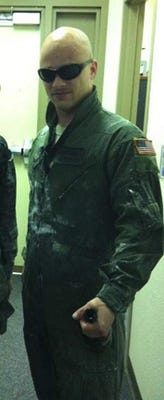source GAIA package: Sx_MilitaryTimes_M6201310306140020_5675.zip Origin key: Sx_MilitaryTimes_M6201310306140020 imported at Fri Jan 8 18:18:10 2016
 The Air Force is disputing the claim of a former Predator sensor operator who claims to have participated in missions that killed more than 1,600 people.
The Air Force is disputing the claim of a former Predator sensor operator who claims to have participated in missions that killed more than 1,600 people.
In a recent interview, Brandon Bryant told NBC that when he left the active-duty Air Force as a senior airman in April 2011, he was presented with a certificate in which he was credited for 1,626 kills.
But that number represents the total number of enemies killed by his squadron for the 3rd Special Operations Squadron at Cannon Air Force Base, N.M., over several years, Air Force officials said.
The Air Force could not provide a number for how many people were killed in missions in which Bryant participated.
"Only a very small percentage of that [enemy killed in action] total can be attributed to any one crew member when assessing actual kinetic activity," Air Force Special Operations Command spokeswoman Capt. Belena Marquez said in an email.
Reached by Air Force Times, Bryant said he had been presented with a certificate that said he had participated in missions between February 2009 until April 2011 that resulted in 1,626 enemy deaths.
He sent Air Force Times a picture of a document with the title "Mission Report for BRYANT, B" that lists 1,626 under "Total EKIAs."
"The Air Force can say whatever they want and the way the military was treating it was these were the total number of people that died in the missions that I participated in — in fact that's how it was explained to me when they first gave it to me," said Bryant, who went on to serve in the Air Force Reserve and left as a staff sergeant in January. "If they want to say that it was the total 3rd SOS numbers, they can go right ahead, but it doesn't change the fact that that's how many people died in little over two years."
However, Bryant clarified that he didn't take a "shot" during the time period on the mission report. Sensor operators do not fire missiles, but they do guide the missiles to their targets.
In total, Bryant was involved in seven missions in which his Predator fired a missile at a target, he said. All of those missions were prior to February 2009. At least 13 people died in those strikes, according to his memory.
During his time in the 3rd Special Operations Squadron, Bryant would fire a laser to guide ordnance released from other aircraft to their targets, a tactic known as "buddy lasing," he said. He also remembers providing intelligence, surveillance and reconnaissance for a mission in which an AC-130 gunship was called in and killed an estimated 150 people.
When shown a picture of the document, Marquez said the "1,626" number is the total for Bryant's squadron, not his personal total.
"The document tracked missions and crewmembers that participated in all the missions," Marquez said. "It does not distinguish between the crew that actually fired the missile and all of the crews that supported the objective over its lifetime. It also does not distinguish between ground force actions on the objective that may have resulted in Enemy Killed in Action."
Bryant said he is confused by the Air Force's response.
While no one told him outright that he killed 1,626 people when he received the mission report, he was told, "that's a big number, you should be proud you participated in these operations," he said.
"I never actually said that they were my personal numbers; I always said that they were numbers of whatever objectives I participated in," Bryant said. "I'm not sure if it's the total of the entire database because why would it be under my name?"
Even if the Air Force is right, it doesn't make Bryant feel any less guilty for taking part in lethal strikes.
"I didn't join the military to kill people," he said. "I ended up in a position where I ended up doing so — not me personally, but me directly participating in events where that would happen."
Since he talked to NBC, Bryant has been harassed from some enlisted airmen in the unmanned aircraft community who feel he has betrayed them, he said.
"I've gotten a lot of threats, like physical threats that they would come and find me and gut me if they could," Bryant said.
But Bryant feels like someone needed to come forward to talk about the consequences of strikes from unmanned aircraft.
"I just believe the American people need to know what their tax dollars are [going] for," he said.





